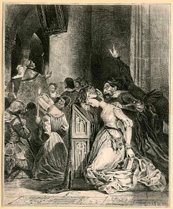
|
|
Marguerite
à l'Eglise
Delteil 70
lithograph, circa 1826,
on medium-weight white vellum paper, the 1st state (of 5), a
very fine and clear impression, trimmed between 1 and 2mm outside
the first borderline, a trial proof of this state, "very
rare" according to Delteil, before the first album edition,
before letters and before the retouching done when the borderline
was subsequently erased, an unobtrusive tear (15 mm) in the lower
right margin that has been expertly repaired with gum, apparently
after a skillful cleaning, small superficial circular skinned
areas on the reverse from an old mount, otherwise in very good
condition
L. (excluding borderline)
269x222mm. (265x220mm. according to Delteil); S. 275x228mm.
|
Provenance: the Alexis
H. Rouart collection, with the wetstamp (Lugt 2187a), faintly
in the lower right corner, and again more clearly on the reverse*
The first album edition
of Faust was published in 1828. One of the first artists
to take interest in the novel technique of lithography, Delacroix
had experimented with it early in his career; the Faust
series however marks his initial attempt at creating an album
in illustration of a literary work, the inspiration for which
derived from a stage performance he attended in London in 1825.
Goethe's appreciation
of this series, in contrast to other contemporary German realisations,
is well known. Beraldi (in Les Graveurs du XIXe Siècle)
further remarks on the significance of this work,
"Delacroix's Faust
today appears to us as wildly romantic. Its importance lies precisely
in this violence. It was a profession of faith of the young school.
At that time, it was not a matter of being reasonable, but of
being 'truculent.' Delacroix was 'truculent,' but he made a revolution
in art."**
This revolution was none
other than the invention of modern illustration.

* There is further an
old annotation in pencil on the reverse, "provenant de
la vente Riesener." The latter attribution, although
probable, is not verifiable in that the Riesener catalogue (April
1879) does not itemize the numerous prints included therein. It
is however well known that L. Riesener (the painter, whose grandfather,
the famous cabinetmaker under Louis XVI, had married Delacroix's
grandmother) possessed an important collection of Delacroix's
early works.
** "Le Faust
de Delacroix nous paraît aujourd'hui d'un romantisme échevelé.
Son importance est precisément dans cette violence. Il
fut la profession de foi de la jeune école. À ce
moment, il ne s'agissait pas d'être raisonnable, mais d'être
'truculent.' Delacroix fut 'truculent,' mais il fit une révolution
dans l'art."

